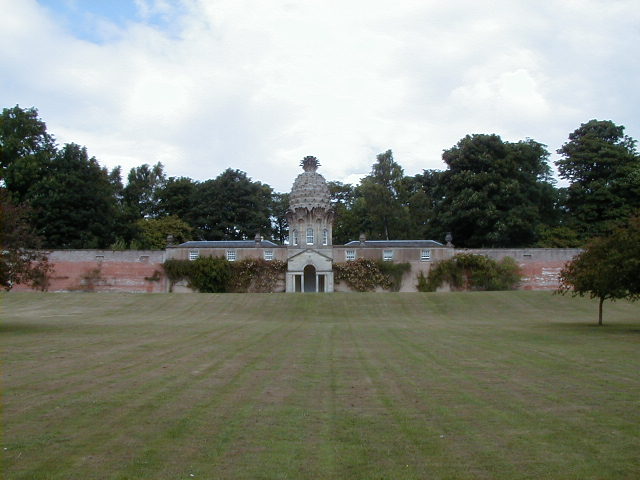The Pineapple

The Pineapple can be found on the western edge of the village. It is a folly par excellence. This gigantic reproduction of the now familiar fruit dwarfs the surrounding trees. It appears to have been built in about 1776, by the 4th Earl of Dunmore, when pineapples were extremelly rare, its rarety made todays luxuries such as caviar, smoked salmon and champagne mundane by comparison. The pineapple was scarcely seen except by the very rich, so what must the locals have made of this stone copy appearing in their midst ? It really is a most extraordinary looking building.
The building was planned and designed with the utmost of care, each of the curved leaves deing drained separately to prevent frost damaging the delecate masonary.
The keystone above the south entrance carries the date 1761. Above this is a carved heart with the inscription "FIDELIS IN ADVERSIS". The inscription is thought to commemorate the marrage of George Murray, the fifth Earl of Dunmore, to the daughter of the Duke of Hamilton in 1803.
The walls to either side were the back of lean-to greenhouses used to grow the pineapples
There are vases on each side of the pineapple which are in fact chimneys for the furnaces that provided the heat for its real fruit. The building was hidden away from the main road in woodland and it is part of a large walled garden.
When methods of keeping the fruits fresh in transit from the tropics improved the greenhouses fell into disuse.
The building had become overgrown by the surrounding woodland and was restored in the late 1970,s.
The building and grounds were then donated to the National Trust for Scotland who now maintain it.
Some years ago the Landmark Trust took the building on a long term lease from the National Trust for Scotland and have carefully restored it for letting as a holiday home.
Unfortunately the designer of this wonderful structure is unknown, it is certainly unique, I have heard that there is one other like it somewhere in Italy but I have not had this confirmed.
The 4th Earl of Dunmore spent 6 years in America. In 1770 he became Governor of New York and he held this post for a year. He then took up the Governorship of Virginia and took up residence in Williamsburg. Here, against orders, he pushed back the colonies boundaries and in 1774 he fought a campain, against the local Native American tribes, which became known as Dunmore's war.
During Lord Dunmore's governership of Virgininia the American war of independance broke out and he found himself in charge of the local Redcoat Army against his erstwhile allies, the settlers. During this conflict Dunmore issued a proclamation which in effect stated that any black slave who deserted their white owners would be granted their freedom. This proclamation was remarkable in the fact that this is believed to be the first time such a promise was ever made to slaves. Prior to this a slave was a slave until death without any hope of freedom.
The pond that is situated in the pineapple grounds has been found to be the habitat of one of Britains rarest amphibians, the Great Crested Newt.
Recently a dipping platform has been constructed at the pond and it is hoped that it will be of great help to local schools etc. to assist in teaching the pupils about this rare creature. It has to be stressed however that ONLY AUTHORISED DIPPING is allowed, to minimise the disturbance to the pond wildlife and especially to the Great Crested Newts. Please be sure to contact the head groundsman and do not disturb the pond in any way without his specific consent.